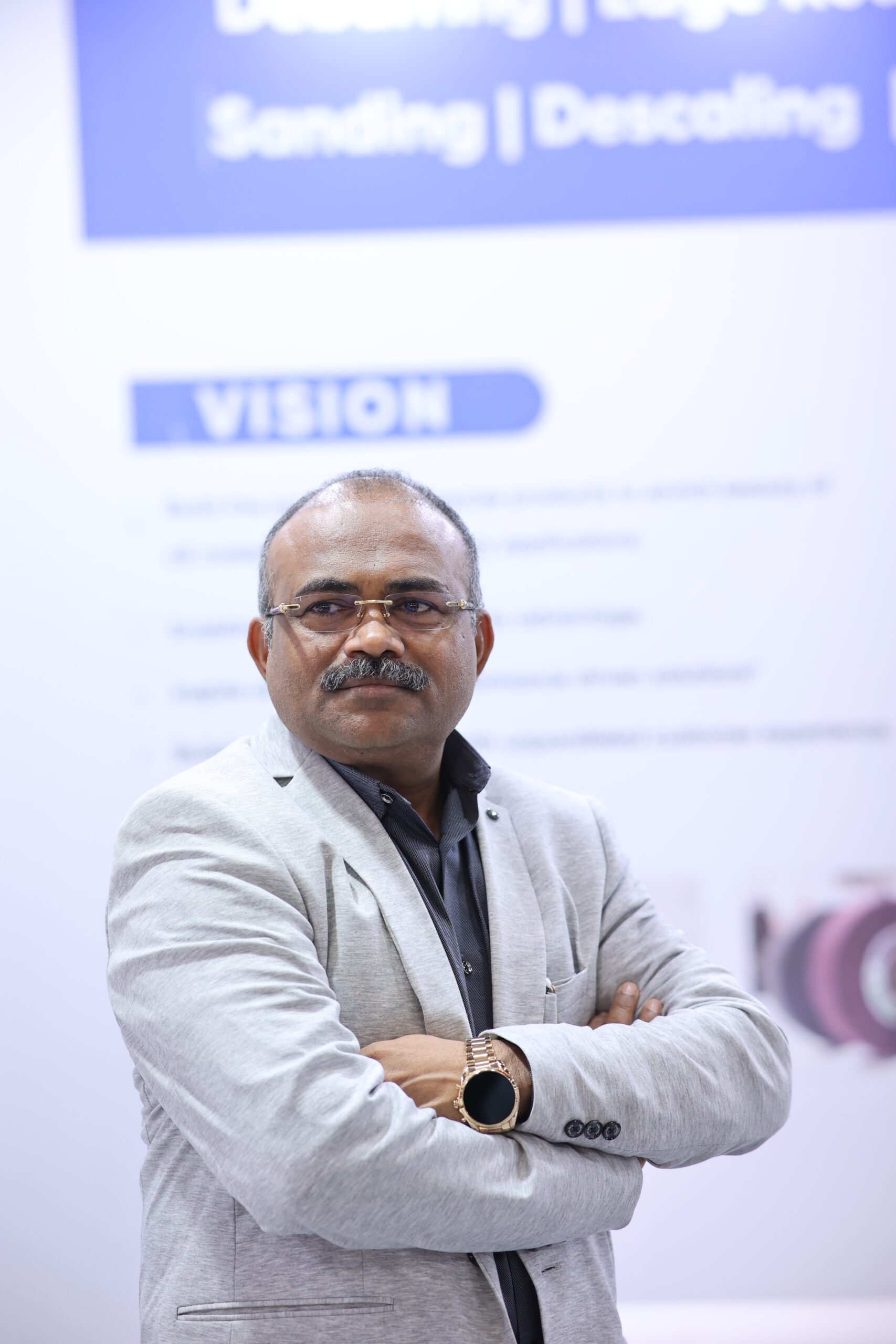Not Just Fair-Weather Partners

Seenivasan Balasubramanian, CEO, IAMPL speaks about the how the company leveraged the unique strengths and rich legacies of Rolls-Royce and HAL to build a world-class manufacturing force
If there is any organization that best represents the orientation of India’s A&D (Aerospace and Defence) sector’s aspirations, it is IAMPL.
A quick look at IAMPL’s genesis reveals why. IAMPL (International Aerospace Manufacturing Pvt. Ltd.) is a joint venture between British aerospace and defence major, Rolls-Royce, and India’s iconic aerospace engineering company, Hindustan Aeronautics Limited (HAL). Established ten years ago, IAMPL has achieved several important milestones and is now counted as a category-leading supplier in India’s A&D manufacturing ecosystem.
Seenivasan Balasubramanian, Chief Executive officer, IAMPL spoke about the company’s journey, its implementation of best-in-league manufacturing techniques, how it negotiated the challenges presented during 2020, and what it plans to showcase at Aero India 2021, with DMI editor Aanand Pandey. Excerpts.
IAMPL was formed in the year 2010. How has it evolved over the years?
IAMPL has evolved over the years to become a fully accredited benchmarking facility within the Rolls-Royce global supply chain. We manufacturer more than 160 different high precision machined, special processed components for technologically advanced civil and defense aero-engines and others. IAMPL has evolved into positioning itself as a competitive, front-ranking supply chain partner for the industry.

Seenivasan Balasubramanian, CEO, IAMPL
Can you share with us a snapshot of IAMPL’s historical milestones?
In 2010, a Memorandum of Understanding (MoU) was signed between Rolls-Royce and HAL to establish IAMPL for supporting global and local aerospace and defense requirements. By 2012, we had a custom-built factory ready for operations and 2012-13 was dedicated to the training of people, with technical support from Rolls-Royce UK. In 2013, we began manufacturing and supply of parts.
Next, we won a large project for supply of parts for the Trent family of civil aero-engines that we subsequently started to manufacture and ship, and later we won additional parts for business aviation engines.
In 2020, we began working on programs with HAL for their defence supply requirements. Presently, having successfully achieved these milestones and gaining experience in the global quality and supply chain requirements, we are also open to exploring opportunities with other engine manufacturers in the industry.
What has been your experience of assimilating Rolls-Royce’s work culture and legacy?
It has been a veritable shift in attitude from day one. Rolls-Royce expects excellence in everything, whether it is in meeting the specifications or in not entertaining any concession on any part. Oftentimes, upon perceiving that a specification looks impossible to execute, we tend to ask for some sort of concession. That doesn’t cut it with Rolls-Royce. They only want to know how you intend to make it possible. That is one of the prerequisites to be a Rolls-Royce supplier. This is a different, unique experience.
Over the last ten years, we have implemented that culture here at IAMPL, which in Rolls-Royce’s parlance is called the Rolls-Royce production system. It is a step-by-step approach implemented right from the stage of process design up to the point of product shipment.
How does IAMPL leverage on the legacies and strengths of both Rolls-Royce and HAL?
We do this in three primary ways: first, implementing the global best practices and standards of quality for the aerospace and defence industry. Second, is implementing the digital production system. And third, our people receive training in industry-best practices and techniques from both Rolls-Royce and HAL.
Today, we have integrated machining technologies and special process capabilities under one roof, which makes us competitive in terms of delivering zero-defect parts faster and with greater cost-competitiveness.
Furthermore, we have developed a digital-twin based manufacturing execution system (MES) with an integrated inspection system in play for every operation. This is another aspect that sets IAMPL apart from the competition. We started implementing this digitally empowered MES from 2018-2019.
Let me share an example of how the digital-twin technology works. When one starts the production of a part, an authorized document – which informs the manufacturing team about the production parameters – called a work order is released. Thereupon it is transferred to the MES, where it waits for its turn based on a predetermined schedule.
As each part undergoes different processes, each step is automatically recorded in the MES. Sometimes an integrated inspection is undertaken as part of the process or to the CMM (Coordinate Measuring Machine) system as the process mandates. The CMM, on its part, sends the measurement data to the operator’s machine.
These operations happen not just once – each part undergoes several operations before it is finally shipped to the customer. Now here comes the interesting bit – each part shipped to the customer has a digital twin stored in our system. This is so that if and when the customer wants to know anything about the manufacturing process of any part at any given point of time, that data can be retrieved and shared immediately. We can proudly say that, in our industry, we have pioneered the digital twin-based manufacturing execution system in terms of integrating it with the production system and using its data for further improvements.
Going forward, we aim to use our performance data for designing of processes. We are working on an AI-based system which can provide, from historical data, best-in-class design, production, and quality processes – including that of the selection of cutting tools – for future programs.
Apart from the digital tech benefitting the customers, in what ways has it helped internally?
It has helped us reduce, and wherever possible, eliminate manual errors and intervention. This is helping our engineers focus more on process improvement. We have completed a pilot project for developing a system-designed quality plan, where the alpha-level accuracy matches or betters the manual effort. This will help us pursue excellence further. We have to demonstrate our capabilities on these parameters because Rolls-Royce continuously evaluates the performance of a vendor, and rates vendor performance on quality, delivery, cost, and management initiatives, among others. A class-leading vendor needs to score 90 percent or more, and I feel proud to say that we are today a class-leading supplier in the Rolls-Royce global supply chain.
I share this to illustrate the point that if India has to become a global hub for aerospace and defense manufacturing, and foster a supplier ecosystem to cater to global players, our engineers have the ability and the vision to do it.
In what ways do these capabilities benefit HAL?
Our constantly evolving capabilities are a natural advantage shared with HAL in all our joint programs. At the same time, there are several other manufacturing techniques where we could and do learn from them. It’s all cumulative. In a way, I see this as supporting our industry ecosystem where we can become class-leading vendors to the world.
What are some of the key measures you have undertaken toward ensuring safety and sustainability?
We are a highly committed to ensuring environmental sustainability. We have zero-liquid discharge systems installed in our campus, which means we don’t let any wastewater or any effluent out. We recycle wastewater to reuse it for our purpose, for instance, we use it in our chiller plant that helps us for air conditioning.
We use LEDs and have adopted IoT techniques for further savings of power. That is a part of our digital drive. We also use IoT-based devices for improving our efficiency in power consumption.
These are some of the developments that are interesting given that today’s technologies offer a lot of opportunity to think about and do things differently. A lot of things that we could only imagine about a few years ago have become a reality today.
The safety of our employees continues to be a top priority for us. We were among the first few operations in the industry to open after the lockdown. We restarted our operation as early as April 2020. Right from the start, we have been very careful and conscious about safety guidelines and have a zero-tolerance approach to any laxity around it. We redesigned our workspaces, rescheduled shift timings, and implemented social-distancing practices from the very beginning which included designating marked spaces for people to stand six feet apart. These guidelines also covered the vehicles that pick up our employees. We have put in place touchless operations, temperature sensors and sanitizer dispensers at all the important points in our factory.
We will continue to educate our employees about COVID-19-related risks and have safeguards in place until everyone is out of the woods here and globally.
What are the solutions and technologies you are showcasing at the Aero India 2021 show?
We will showcase our integrated capabilities of machining, special processes and demonstrate how all that is coupled with our digital manufacturing execution system, all available under one roof.
The aerospace and defence sector operates at the leading edge of technology. How do you keep your processes and capabilities at pace with the technological developments and industry demands?
Our skills, driven by our imagination, have taken us to the next level. We must continue to imagine the future, about what, for instance, could be the next frontier for better analysis and delivery. Our ability to visualize the future has helped us develop an intelligent manufacturing system.
We have to be very aware that it’s our own people who will shape and steer whatever processes we are putting in place; the only thing we can give them is technological advantage, a support system and expose them to newer technologies like IOT or artificial intelligence. We continuously train our people, imparting new and multiple skills with the help of industry experts. These are the things we continuously need to do as a leader.
Technologies are evolving at a faster pace today. Ten years from now, the job description of our engineers will be very different from what it is today and we need to ensure they evolve with the times. We need to keep in view the benchmarks of excellence that are going to be in play in the future.
Civil aviation has been the worst hit sector in 2020. Major OEMs like Boeing and Airbus are trying to consolidate and insource a lot more in terms of their supplies. This has had a cascading impact on component manufacturers. From an industry perspective, how do you see these headwinds impacting the supplier ecosystem?
There is no doubt that times are tough, and it is during the times of crisis that it becomes even more important to tell customers that we stand with them, and that we are not just fair-weather partners, we are your partners in progress. And that is what we are continuously doing.
Secondly, we have made eliminating waste from our system a priority; we have declared a war on waste. We put a sharp focus on any operation that can be made leaner – whether it is inventory planning or freight cost or in determining the right batch sizes, or in reducing the setup or any type of rework on the shopfloor. We are focusing on becoming an even more agile partner to our customers. That is what I meant by supporting our customers better than before in times of crisis.
Thirdly, we have set our sights on winning new projects in both the defence and civil aviation sectors. As you pointed out, the industry is witnessing a wave of rationalization. We see it not as a challenge but as an opportunity – an opportunity to use data and digital technologies to design our processes better, to further improve our speed-to-market, and deliver new products. We demonstrated this in 2020 when we delivered much greater number of parts than we did in 2019. And we will continue to demonstrate our ability to deliver excellence in 2021 and beyond.
IAMPL Supports Vision of Strong, Self-Reliant Indian Defence Sector
– Kishore Jayaraman, President, Rolls-Royce India & South Asia
“IAMPL is a great joint venture success of Rolls-Royce and HAL. It has been a phenomenal journey together to drive quality parameters and execution excellence to become one of the best suppliers to Rolls-Royce. All credit to the IAMPL team for their hard work and perseverance in achieving this success, and for completing ten glorious years as leaders in the high-precision component manufacturing sector. Rolls-Royce has been partnering the Indian armed forces for over 87 years, and today, over 750 Rolls-Royce engines across 10 engine types, power Indian military aircrafts. As India pursues its self-reliance ambitions and undertakes defence modernisation programmes, Rolls-Royce is committed to providing the best value and highest quality products possible. We recognize the evolving requirements of India’s defence sector and have been working to strengthen the ecosystem for Aerospace and Defence in the country. We believe that IAMPL is well-positioned in the manufacturing ecosystem to support the vision of a strong and self-reliant Indian defence sector.”
Do Visit for more Information http://www.iampl.co.in/
This Article was published as the cover story in Dynamic Manufacturing India Jan-Feb 2021 issue Written by Aanand Pandey , Editor in Chief , Meshmix Media Pvt Ltd





